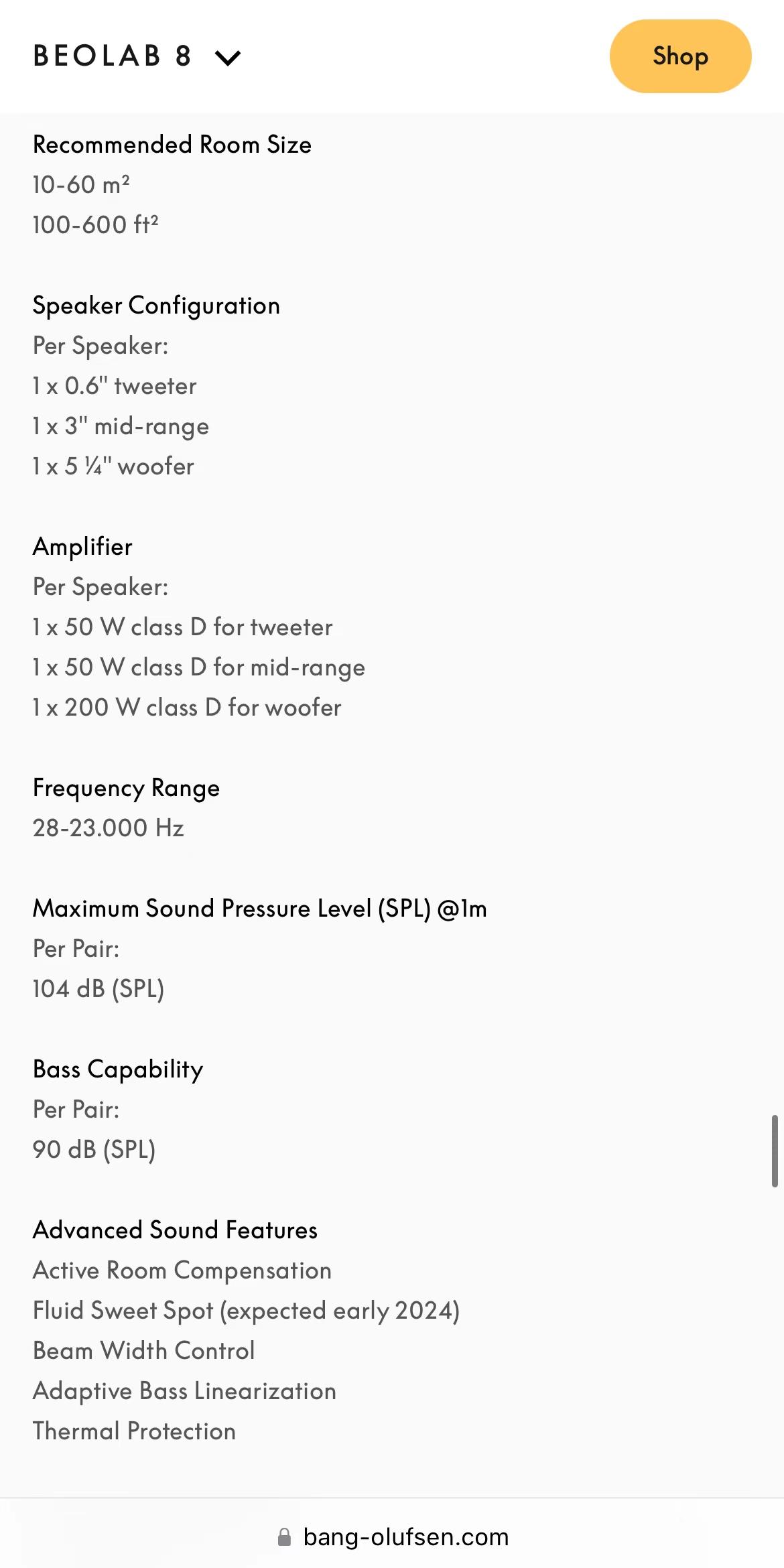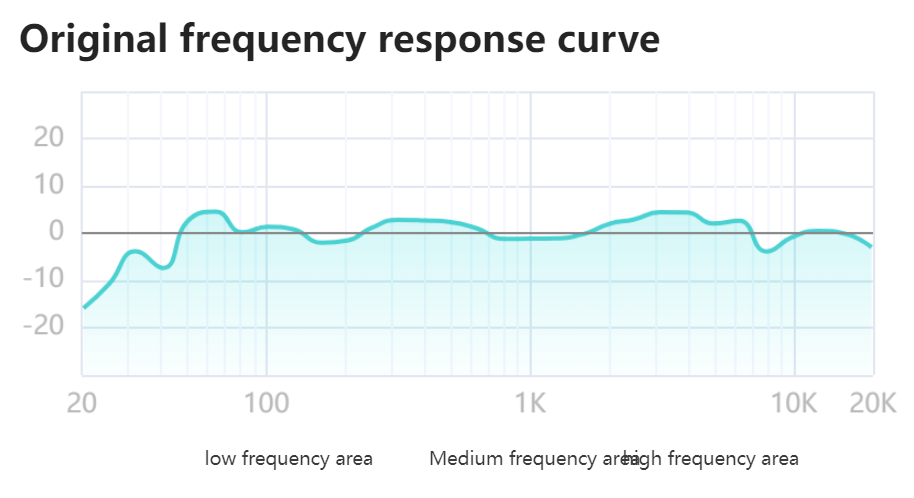Beolab 8 frequency range
Tagged: beolab8
- This topic has 9 replies, 6 voices, and was last updated 1 year, 1 month ago by
solidkd.
- AuthorPosts
- January 9, 2024 at 9:20 am #28418
Bo refresh the lab8’s pages and add the “frequency range”
 January 9, 2024 at 9:42 am #28421
January 9, 2024 at 9:42 am #28421Here is a response graph which tested by a cn kol
 January 10, 2024 at 10:18 pm #28535
January 10, 2024 at 10:18 pm #28535From my audition in store I am surprised to read the bass number. Even more so when compared to BeoLab 17 figures…
Frequency Range
31 – 24,000 Hz
Maximum Loudness @1m (SPL)
106 dB SPL
Bass Capability
90 dB SPLJanuary 10, 2024 at 10:54 pm #28540I would say these are just marketing statistics?
im sure a 200W D-class ICE amp can deliver a lot of “oomfph” thru a 5in driver in the in the 90-250hz range but it will significantly less efficient in the 28/31 to 90hz range especially if that amp has to deliver sound at higher volumes etc…..
it’s still there but not at unlimited full-fat, unlimited quantities?
January 11, 2024 at 1:53 pm #28565I always took that to be what they meant by the ‘bass capability’ figure. E.g. they achieve the stated (not that it’s stated to us in the spec sheet for all models) bass response up to that SPL level (inferring that upwards of that the ABL is kicking in to limit it).Edit – turns out I’m totally wrong! See below 🙂I would say these are just marketing statistics? im sure a 200W D-class ICE amp can deliver a lot of “oomfph” thru a 5in driver in the in the 90-250hz range but it will significantly less efficient in the 28/31 to 90hz range especially if that amp has to deliver sound at higher volumes etc….. it’s still there but not at unlimited full-fat, unlimited quantities?
January 12, 2024 at 7:19 am #28583There may be some incorrect assumptions about what the terms “Frequency Range” and “Bass Capability” mean.
I explained “Frequency Range” a long time ago in this blog posting:
http://www.tonmeister.ca/wordpress/2014/10/15/bo-tech-reading-specifications-part-1/
Note that a graph in a magazine is probably / usually created by doing one measurement in one location in front of the loudspeaker. This is equivalent to evaluating a television by measuring a single pixel – in other words, it can be worse than useless (we often say that, when it comes to a loudspeaker, one measurement is typically worse than no measurements). If you’re going to find a reasonably good representation of frequency range, you have to take a weighted average of a number of measurements at different angular directions in order to be fair/representative/useful.
Bass Capability is a measure of the maximum output level for the loudspeaker at a given narrow frequency range for a given amount of time.* This has nothing to do with Frequency Range (in the same way that top speed of a car has nothing to do with its 0 – 100 km/h acceleration time). I touched on this (at least intuitively) in this blog posting:
http://www.tonmeister.ca/wordpress/2013/12/13/bo-tech-what-are-subwoofers-really-for/
Hope that helps clear up any confusion.
Cheers
-geoff* It’s important to remember that ABL protects the loudspeaker from clipping caused by over-excursion of the loudspeaker driver, or attempting to exceed the limits of the amplifier voltage / current or the power supply current. However, there is also thermal protection that pulls back the output of a loudspeaker driver to prevent it from melting the voice coil. If you play at maximum level for a period of time, the thermal protection starts working and the level will go down. So, the Bass Capability is the output level before that starts happening. If you’re playing a sine wave, you can hear this behaviour as a simple ramping-down. However, since music & movie sound is much more dynamic, the behaviour is much more complex.
January 12, 2024 at 2:22 pm #28599There may be some incorrect assumptions about what the terms “Frequency Range” and “Bass Capability” mean.
Yes Geoff, a big problem is that the 1% of B&O customers in this forum – including myself make incorrect assumptions so what do the other 99% of general B&O customers think/know about bass capacity or other detailed principles of loudspeaker acoustics? Nothing I assume? So why do B&O market this new specification. It’s not a general market sector bench mark for sales and I’m pretty sure a very high percentage of B&O Dealers won’t know what it means either.
January 13, 2024 at 11:52 am #28614There is no industry-wide standard for specifying the Frequency Range of a loudspeaker, so each manufacturer uses their own definition which allows (potential) customers to compare within a single brand. B&O has not changed its definitions for at least as long as the 20 years that I’ve worked here. (Note that this is not a new specification – I guess that it’s just been newly added to the Beolab 8 page.)
While it might be arguable that a single standard for passive loudspeakers is a good idea, this would not be applicable to active loudspeakers due to dynamic processing, which immediately raises the issue of which output level to use for such a measurement. (For example, when ABL starts protecting a B&O loudspeaker, it reduces the frequency range, if only temporarily.)
I would argue that it’s a bad idea to make an industry-wide standard unless it’s generalised so much that it’s useless. Consider, for example, the difficulty of creating a single standard that would be applicable to loudspeakers with very different directivity patterns: a dipole electrostatic and an omnidirectional loudspeaker.
I certainly agree with your implication that it would be difficult/impossible to correlate loudspeaker sales with these technical specifications, which also would indicate that these technical specifications are not important factors for most of our customers. However, this does not mean that we should not make them public – we definitely should, in the same way that car manufacturers publish horsepower (despite the fact that most people only care about torque in most day-to-day driving).
If our dealers (or their sales staff) don’t understand what these specifications mean, then it means that there is a weak link in our internal education. I am one of the people who educate the trainers and develop the training materials to teach the sales staff. Of course, there are links in this chain, but our sales staff should either know what these specifications mean, OR they already have the resources to find that information quickly.
That said, I completely agree with you that the biggest problem here is that our customers might make assumptions about what these numbers mean and assumptions are frequency incorrect. This means that I have a job this week to contact our marketing department to start figuring out how we can put an easily-accessible glossary on our website that explains the specifications so it’s easy to find out what the numbers mean, and how they can be used correctly. This isn’t as simple as it sounds due to the necessity of ensuring that it’s available in a number of languages – so don’t expect something to show up next week.
However, I’m happy to spend some time here explaining how the measurements are done if there are any questions. That’s exactly why I’m “allowed” to contribute to beoworld – to clear up technical questions and confusion.
Cheers
-GeoffJanuary 13, 2024 at 9:49 pm #28622I currently have Beosound 2 and before I made my decision I have looked at the frequency range just to know which one of solo beo speakers is the best. Guess what? After listening to all of them, this one was the best sounding for my music mix. For me beosound has the deepest bass although balance and A9 on paper have similar specs. Comparison with horsepower is good, you can buy a 500 horsepower american musle car but 300 horsepower hatchbacks are just as fast and much more nimble and practical most of the time. And I have experienced it with beosound 2. I never use 90% volume nor deepest bass settings. It is just not practical in Real world to go full throttle. Most of the time I just want to relax listening my favourite music.
I am looking at the Beolab range now, and I would also want to hear them all before deciding, but all other things aside, reading the specs one could think:
beosound 2/a9/balance > beolab18 > beolab 8 > beosound Theater > beolab 28
Is that a thing guys? Considering specs only, and all other functions, stereo vs solo things aside. Reading just the specs: frequencies, 1m spl and bass possibilities?
By the way Geoff it is so wonderful to read the thoughts of an artist about they work! I love interviews with movie creators just like I love reading Geoff thoughts about sound and Bang Olufsen has always been art for me while the others are just sound equipment.
January 15, 2024 at 3:02 am #28660Thank you Geoff, your blog just open my mind
- AuthorPosts
- You must be logged in to reply to this topic.
